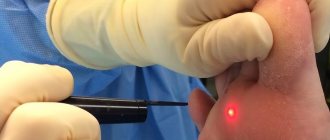Hiroshima, Nagasaki, Chernobyl are black pages in the history of mankind associated with atomic explosions. Negative radiation effects were observed among the affected population. The effect of ionizing radiation is acute, when the body is destroyed within a short time and death occurs, or chronic (irradiation with small doses). The third type of influence is long-term. It causes genetic effects of radiation.
The impact of ionizing particles varies. In small doses, radioactive radiation is used in medicine to combat cancer. But it almost always has a negative impact on health. Small doses of atomic particles are catalysts (accelerators) for the development of cancer and breakdown of genetic material. Large doses lead to partial or complete death of cells, tissues and the entire organism. The difficulty in monitoring and tracking pathological changes is that when receiving small doses of radiation, there are no symptoms. The consequences can take years or even decades to appear.
The radiation effects of human exposure have the following consequences:
- Mutations.
- Cancers of the thyroid gland, leukemia, breast, lung, stomach, intestines.
- Hereditary disorders and genetic code.
- Metabolic and hormonal imbalance.
- Damage to the organs of vision (cataracts), nerves, blood and lymph vessels.
- Accelerated aging of the body.
- Sterility of the ovaries in women.
- Dementia.
- Disorders of mental and mental development.
Classification of burns
There is no single generally accepted classification for eye burns. They are usually divided according to the type of damaging factor, location and depth of damage.
Depending on the characteristics of the damaging factor, burns are divided into chemical, radiation and thermal. In cases where there are several influencing factors, a thermochemical burn develops.
Based on the location of the lesion, it is customary to distinguish burns of the eyelids, cornea, conjunctiva, choroid, retina, and lens.
According to the depth of damage, eye burns come in 4 degrees of severity (according to Polyak). The mildest is a first degree burn, its outcome is favorable in almost 100% of cases. More severe degrees (II – IV) of eye burns are treated only in a hospital; the consequences of such a lesion are sometimes extremely severe.
Dangerous complications
Deep radioactive burns often cause complications. They are divided into 2 groups:
- Local – pathological changes in the affected areas. Non-healing ulcers, fistulas, and abscesses appear on the skin.
- General – dysfunction of vital systems. Changes occur in the functioning of the hematopoietic, cardiovascular, nervous, immune and other systems.
The mildest complications include radiation hangover, which is manifested by loss of appetite, decreased blood pressure, and emotional lability. Under the influence of radiation, neurological disorders, insomnia, and baldness occur.
The most dangerous complications occur with radiation sickness. Its symptoms depend on the total dose of radiation absorbed by the skin. Late consequences include:
- aplastic anemia - inhibition of the functions of the hematopoietic system: the synthesis of red blood cells, leukocytes, platelets by the bone marrow stops;
- Radiation cataract – clouding of the lens caused by radiation;
- pneumosclerosis - the formation of connective tissue adhesions in the lung tissue;
- radiation proctitis – inflammation of the rectum provoked by high doses of radiation;
- leukemia is a malignant blood pathology in which the bone marrow begins to produce immature leukocyte cells.
Some delayed complications are fatal. Radiation doses of more than 1 Gy (100 rad) are often accompanied by pathologies of the bone marrow and gastrointestinal tract.
Symptoms
The depth and extent of the burn, as well as the period that has passed since the injury to the eye, are decisive when the patient complains. Symptoms of a burn are usually as follows:
- The skin of the eyelids is swollen and red.
- There is severe pain and irritation of the eyes.
- Swelling and hyperemia of the eye mucosa (conjunctiva, cornea) develops
- Watery eyes and photophobia occur.
- A violation of the transparency of the cornea is detected.
- Visual acuity decreases, visual fields narrow.
- There may be an increase or decrease in pressure inside the eye.
Radiation burns often do not cause some of these symptoms, since infrared or laser beams primarily affect the cellular tissue of the choroid and retina.
It is worth remembering that the severity of the injury cannot always be determined immediately after an eye injury. A victim with an eye burn, regardless of its severity, must be urgently transported to a medical facility, where he will be shown to a specialist. Often, the prognosis of the disease is directly related to the speed and volume of specialized care.
Classification of lesions due to radiation exposure
Exposure to radiation leads to damage to the intracellular apparatus and cell functions, which subsequently causes their death. The most sensitive cells are those that divide rapidly - leukocytes, intestinal epithelium, skin, hair, nails. Hepatocytes (liver), cardiocytes (heart) and nephrons (kidneys) are more resistant to radiation.
Radiation effects of exposure
Somatic consequences:
- acute and chronic radiation sickness;
- eye damage (cataracts);
- radiation burns;
- atrophy and hardening of irradiated areas of the skin, blood vessels, and lungs;
- fibrosis (proliferation) and sclerosis (replacement with a connective structure) of soft tissues;
- reducing the quantitative composition of cells;
- dysfunction of fibroblasts (cell matrix, the basis for its appearance and development).
Somatic-stochastic consequences:
- tumors of internal organs;
- malignant blood changes;
- mental retardation;
- congenital deformities and developmental anomalies;
- cancer in the fetus due to exposure to radiation;
- reduction in life expectancy.
Genetic consequences:
- change in heredity;
- dominant and recessive gene mutations;
- chromosomal rearrangements (changes in the number and structure of chromosomes).
Thermal burns
Thermal are eye burns that occur when exposed to high or extremely low temperatures, including exposure to hot liquids, fire, steam, burning or hot solid particles, dry ice, as well as cryogenic liquids and liquefied gases. Such burns, as a rule, are localized in the anterior part of the eye, and damage to the deep ocular structures can be observed only in severe cases.
If a thermal burn occurs, traces of the traumatic substance should be removed if possible and the eyes should be rinsed under a weak stream of water. The skin around the eye is lubricated with an antiseptic or antibiotic ointment (for example, tetracycline ointment), the same ointment should be placed behind the eyelid. The eye is covered with an aseptic bandage, and scratching or rubbing it is strictly prohibited. The patient is hospitalized as quickly as possible.
First aid for electrical burns and electrical injuries
- Assess the situation. You should not immediately touch the victim - he may still be under the influence of current. If you touch it, you will also be hit. If possible, turn off the power source (switch, plugs). If this is not possible, move the power source away from you and the victim. This can be done with a dry, non-conductive object (wooden stick, branch, etc.)
- If you move the victim away from the electrical wire, do not touch exposed parts of the body naked - they conduct current. You can only touch dry parts of his clothes. If possible, use rubber gloves or wrap your hands in a dry silk cloth.
- After the electricity has stopped, assess the victim’s condition: is there breathing and a pulse. If not, it is necessary to urgently carry out resuscitation measures: closed heart massage and artificial ventilation.
- Inspect exposed areas of the victim's body. Find 2 burns - the entry and exit points of the electrical discharge. Place a sterile, lint-free cloth over them. Do not use towels or blankets - their fibers may stick to the burn.
- Lay the person so that the chest is slightly lower than the legs - this will increase blood flow to the heart and improve its functioning.
- Hospitalize the victim as quickly as possible.
Important! Before providing assistance, make sure there are no metal objects on you. Do not touch the victim with bare hands while he is under voltage. Avoid contact with water.
Chemical burns
Chemical burns to the eyes are usually caused by exposure to acids or caustic alkalis. In everyday life, they are caused by the ingestion of crystals of potassium manganese, ammonia, iodine, lime, various cosmetics, and household chemicals.
The peculiarity of chemical burns is the duration of exposure to the damaging factor. After all, when alkali, for example, gets into the eye, it can damage not only the tissues localized at the point of direct contact, but also penetrate into the deep parts of the eye.
If chemical agents come into contact with the eyes, they must be immediately rinsed under a weak stream of water (at least 10 - 15 minutes, until traces of this substance disappear from the eye). Then, you need to put antiseptic eye drops into your eyes, and lubricate the skin around with antiseptic ointment. After which it is better to cover the affected eye with an aseptic bandage and send the victim for an ophthalmological examination.
Proper first aid
Further recovery depends on how competent first aid is provided for a 2nd degree burn. The procedure is as follows:
- Remove the source of damage.
- Rinse the damaged area under running cold water.
- Treat the skin with an alcohol-free antiseptic.
- Apply a sterile bandage.
- Give pain medication as needed.
But here is what you should absolutely not do in case of a 2nd degree burn:
- tear off clothing stuck to the wound;
- cool the burn with ice;
- bandage the wound tightly or use cotton wool in the dressing;
- Lubricate the damaged area with oil, sour cream or alcohol.
After providing first aid, you should consult a doctor. Only a specialist will determine how to treat a 2nd degree burn and give individual recommendations. As a rule, such lesions are treated at home. The exception is burns of the respiratory system and esophagus.
Radiation burns
Depending on the type of damaging factor, radiation burns to the eyes may have some characteristics. Such burns occur from exposure to short-wave (UV rays) or long-wave (infrared rays) radiation. Especially often, such damage is detected after visiting solariums, at ski resorts (snow ophthalmia or blindness), and among electric welders.
Radiation burns appear only after a few hours (after about 4 - 6 hours), while typical complaints are: severe pain in the eyes, photophobia, lacrimation, sharp deterioration of vision due to damage to the retina. As with other eye burns, with radiation injuries the patient needs immediate help. What are pain-relieving eye drops (“Inocain”), corticosteroids (“Hydrocortisone ointment”, “Dexamethasone”), drugs that relieve local swelling and oil vitamin solutions (“VitA-Pos”), antibacterial drugs (“Floxal”, ( "Levomycetin").
Further therapy
Radiation burns are treated in a hospital or at home. Features of therapy are determined by the depth and area of the lesions. To speed up the regeneration of affected areas, a high-calorie diet is prescribed. Particular attention is paid to the drinking regime. Drinking plenty of water speeds up the elimination of toxic substances from the body.
For superficial damage, local therapy is limited.
Bandages soaked in antiseptics are applied to the affected areas. When weeping, applications of a 10% dimexide solution are used. To speed up scarring, bandages with troxevasin and levosin are used.
Treatment of burns after radiation therapy is carried out with drugs from the following groups:
- antihistamines (Diphenhydramine, Suprastin) – relieve inflammatory reactions and swelling;
- painkillers (Analgin, Ketanov) - reduce pain;
- antibacterial (Levomycetin ointment, Baneocin) – destroy bacteria, preventing purulent inflammation of wounds;
- corticosteroids (Elocom, Lorinden) – relieve acute inflammation, itching and irritation;
- wound healing (D-Panthenol, Sudocrem) - soften the affected areas, stimulate the healing of the epidermis.
For deep injuries, in addition to local therapy, surgical care is required:
- necrotomy - dissection of charred skin down to viable layers;
- necrectomy - removal of dead skin, gangrenous areas;
- skin grafting – closing wound defects with artificial or own skin.
For radiation sickness, restorative and immunostimulating drugs are prescribed. The treatment regimen depends on the patient's condition and the extent of the damage.
Treatment of eye burns
First aid provided for eye burns, regardless of the type of burn, should be aimed at eliminating the damaging agent (chemical, temperature or radiation), applying antibacterial eye drops (Levomycetin, Albucid, Sodium Sulfacyl, etc.), laying ointments (“Tetracycline ointment”, “Floxal”). This is done to prevent the development of secondary infection in damaged eye tissues. Then, as a rule, a sterile bandage is applied to the eye and the victim is taken to the hospital.
Treatment of eye burns should only be carried out by an ophthalmologist. The choice of necessary drugs, the frequency of their application and the duration of use depend on the type of burn, its degree, and other individual factors.
Actions for sunburn
- At the first sign of injury, take the victim to the shade and cool the skin with cold water. It is best to take a cool shower for 15-20 minutes, then apply a cooling compress to the skin.
- Apply the medication, preferably in spray form. For example, drugs containing panthenol.
- Give the victim plenty of fluids.
- Monitor his condition. If dizziness, nausea, vomiting, chills, or fever occur, call a doctor. It is also worth calling a doctor if there is extensive skin damage.
To prevent sunburn, be sure to use SPF before going out in the sun and avoid sunbathing during dangerous times – from 11 a.m. to 3 p.m.
Regardless of the type and degree of damage, even if it is a small thermal burn, it is necessary to monitor the condition of the victim. In case of loss of consciousness, problems with breathing or pulse, call a doctor immediately.
When providing first aid, do not forget about your own safety and use latex gloves. If during the process the victim was given any medications, for example, painkillers, be sure to convey the information to the doctor, indicating the name of the drug.
Consequences and prognosis
The consequences of eye burns are determined by the depth of damage, the type of damaging factor, the severity of tissue damage and the timeliness of treatment.
Burn injuries to the eyes of II – IV degrees are accompanied by certain complications and do not go away without leaving a trace. In the tissues of the eye, scarring may occur, disruption of the lacrimal ducts, decreased transparency of the cornea, development of dry eye syndrome, cataracts or glaucoma. The outcome of burns can be damage to retinal cells in the macular area and the occurrence of irreversible blindness.
In the medical department, everyone can undergo examination using the most modern diagnostic equipment, and based on the results, receive advice from a highly qualified specialist. The clinic is open seven days a week and operates daily from 9 a.m. to 9 p.m. Our specialists will help identify the cause of vision loss and provide competent treatment for identified pathologies.
You can make an appointment at the Moscow Eye Clinic by calling 8 8 (499) 322-36-36 (daily from 9:00 to 21:00) or using the online registration form.










